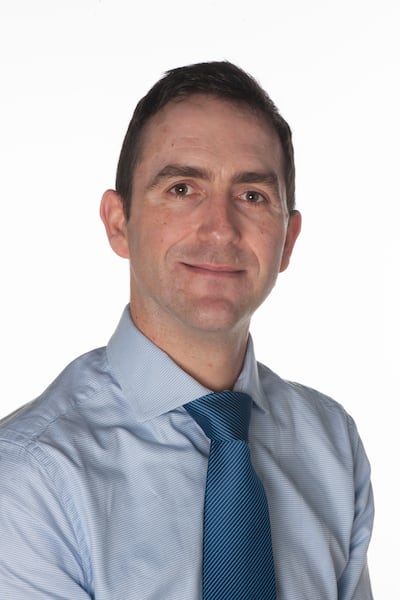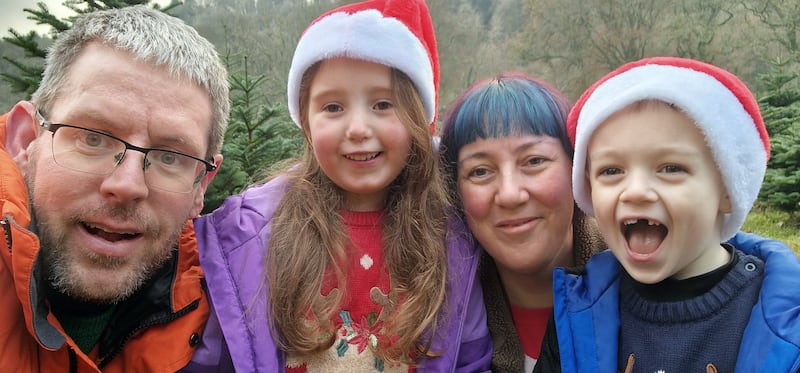
Parkinson’s disease is usually seen as a disease of old age, but a significant number of younger people are diagnosed with it. Diagnosed with early-onset Parkinson’s at the age of 31, Ivan O’Regan was particularly young to have the condition.
“I was an accountant and on the computer all the time,” says O’Regan, who is now 42. “I began to notice that I had trouble cutting and pasting text with my left hand. I also found that I was holding my left arm into my chest. I went to my GP. He knew straight away what it was, but he didn’t tell me at first. He sent me to a neurologist who told me I had Parkinson’s.”
O’Regan started on low-dose medication, in tablet form, that had to be increased as the condition progressed. “I never really had a shake. It was a stiffness and slowness of movement down my left side. I had a bar on the side of the bed that I’d use to pull myself out of the bed. I spent long periods of time sitting in a chair,” he explains. Stiffness and cramping in muscles and limbs – as opposed to a shake or cognitive decline – are the early symptoms most often seen in younger people with Parkinson’s.
To try to alleviate his symptoms further, O’Regan began to use an apomorphine pump which distributes an even dose of dopamine (the chemical whose absence causes Parkinson’s symptoms) throughout the day. And while the pump allowed the medication to be absorbed into his blood stream better than the tablet form, it often made him nauseous. This side effect was so disruptive that O’Regan began using the pump less consistently.
RM Block
The medication problems were putting a strain on our relationship and on Ivan’s mental health. We had also started talking about Ivan getting deep brain stimulation surgery in the UK, but, once Covid hit, the hospital in London stopped taking patients from Ireland
In 2017, Ivan and Eleanor’s daughter Effy was born, and when it was time for Eleanor to go back to work, Ivan took time off work to look after her. In 2018, their son, Ellis was born. During this time, O’Regan’s Parkinson’s symptoms worsened and he was unable to return to work.
“Parkinson’s had progressed faster than we had been expecting. O’Regan signed up for the Duodopa pump, but the HSE had taken it off the market at that time,” explains Eleanor.
The Duodopa pump delivers a synthetic form of dopamine (levadopa) – as well another active ingredient (carbiodopa) to reduce the side effects of the levadopa – through a tube into the abdomen. During a two-year period while the HSE negotiated the price with pharmaceutical company AbbVie, the medicine was denied to Irish patients.
Eleanor recalls how not being able to have this medicine was a big setback for the couple. “The medication problems were putting a strain on our relationship and on Ivan’s mental health. We had also started talking about Ivan getting deep brain stimulation surgery in the UK, but, once Covid hit, the hospital in London stopped taking patients from Ireland.”

Prof Richard Walsh, consultant neurologist at the Mater Hospital in Dublin, says that deep brain stimulation has been “the gold standard treatment for advanced Parkinson’s disease and some related movement disorders for over 25 years”. During surgery, electrodes are placed in the brain. These electrodes emit an electrical current to circuits within the brain which then regulate abnormal movements in the body.

In 2021, O’Regan began to pursue the possibility of having deep brain stimulation surgery in Ireland, as consultant neurosurgeon Catherine Moran moved to Beaumont Hospital to initiative the surgical procedure here.
Before he could be put on a list for surgery, O’Regan had to go to the Mater hospital in Dublin for a pre-operative assessment. Pre-operative assessments are crucial to working out which patients are most suitable for this very invasive surgery.
Deep brain stimulation doesn’t work for everyone with Parkinson’s. Speech and balance don’t get better with deep brain stimulation
They include the levadopa challenge, which tests the patient’s responsiveness to high levels of medication, cognitive tests to check mental capacity, and physiotherapy checks if patients are physically fit enough for the surgery.
“Deep brain stimulation doesn’t work for everyone with Parkinson’s. Speech and balance don’t get better with deep brain stimulation. The surgery improves the abnormal movement that the majority of people with Parkinson’s have. It also works very well for patients with a bad tremor,” explains Moran.
Following his assessment, O’Regan was confirmed as a suitable candidate for deep brain stimulation. And less than one year later, he was called for pre-operative MRI scans. In February 2022, he became one of the first patients in Ireland to have deep brain stimulation surgery. “I couldn’t wait for it at that stage. The day I had surgery, I wasn’t nervous at all. It was, like, get me in there,” says O’Regan.
Five weeks passed before the devise could be switched on by Prof Walsh, giving O’Regan time to recover from surgery. “The first time Prof Walsh turned it on. I reacted very well. Initially, the device is calibrated every four to six weeks, and then I go for checkups every six months,” he explains.
O’Regan says that life has been transformed since his surgery. “Effy started school this year and Ellis goes to pre-school. We wouldn’t have been able to manage without the surgery. I pick them up from school every day.”
O’Regan, who looks after the couple’s two children during the day, is also confident to have their friends visit since having the surgery. Another big benefit is that he sleeps much better. Previously, he only slept three to four hours at night, which also disrupted Eleanor’s sleep.
Eleanor says that the surgery has made a huge difference to their lives. “We’re not looking to scale mountains. We just wanted to get back to living a relatively normal life and the surgery has given us that.”
“We know that it’s not a cure, but if Ivan didn’t have deep brain stimulation, I’m not sure where we’d be. I certainly wouldn’t have been able to be in full-time employment. I’m not even sure that we’d still be a couple or that Ivan would still be with us because of the mental strain of everything.”
The couple, who live just outside Blarney, are involved with the Cork Parkinson’s Association. “We’re open to people interested in the surgery talking to us privately about it,” says Eleanor.
The population’s needs are for 40 cases a year, and we will always be behind if we only do 20 a year
Prof Walsh says that globally, there is a huge shift to offer deep brain stimulation to younger patients with Parkinson’s disease. “We would typically have waited until patients were living with Parkinson’s for 12-15 years before considering deep brain stimulation as a last resort,” he says. “This meant that patients going through surgery had less time to enjoy the benefits of deep brain stimulation before other challenging symptoms such as dementia and falls emerged,” he explains.
Now, patients are selected based on the longer-term benefits to their quality of life once they pass the pre-operative assessments mentioned earlier.

Catherine Moran has carried out 23 deep brain stimulation surgeries from when the service began in November, 2021 until the end of December, 2022. Both she and Prof Walsh are calling on the HSE to make more theatre space available for this crucial surgery as demand has increased since it became available in Ireland.
Private patients whose health insurance covers their treatment in the UK are still sent there for treatment, while other patients can wait for over a year to have the surgery in Ireland.
“Our business plan for deep brain stimulation to the HSE in 2020 called for 40 cases a year, but due to theatre capacity, we have only been able to do about 20 cases a year. The population’s needs are for 40 a year, and we will always be behind if we only do 20 a year,” says Moran.


















